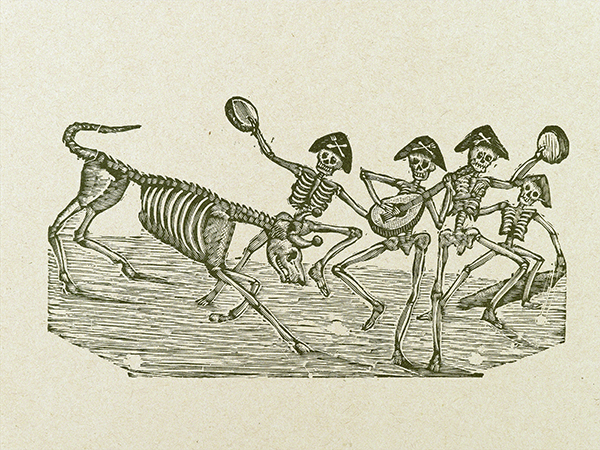Hispanic Heritage Month: Manuel Manilla
The rich tradition of satiric graphic arts in Latin America reaches back to Mexico in the late 1700s. At that time, caricatures of skeletons (called calavera) were adopted by the satirical press as metaphors for political and clerical corruption and government abuses. The work of Manuel Manilla played a key role in the dissemination of the calavera genre in the late 1800s, when the Mexican Revolution (ca. 1910–1920) was on the horizon. His work and that of José Guadalupe Posada (1856–1931) would nourish many subsequent printmakers, most notably those who formed the Taller de Gráfica Popular (Peoples Graphics Studio) founded in Mexico in 1937. The democratic nature of Mexican printmaking also inspired the Mexican mural movement, most notably the work of Diego Rivera (1886–1957).
 |
| Manuel Manilla (1830–1890/1900, Mexico), Calavera Bull Fighters, from the portfolio 330 Original Engravings, ca. 1895–1899. Wood engraving on paper, 11" x 14 7/8" (27.9 x 37.8 cm). © 2023 Brooklyn Museum. (BMA-1574) |
Día de los Muertos (Day of the Dead) dates back to the Aztec culture (flourished 1325–1519/1521), who honored their ancestors in a festival that lasted for a week in late July. The event was overseen by the goddess of the dead, Mictēcacihuātl, who was the partner of Mictlāntēcutli, the god of the dead who ruled Mictlān, the lowest level of the underworld. The Roman Catholic Church in Mexico moved the festival to November for All Hallows Day, when the Church honors the dead of a particular community.
Viewing death as a normal part of mortal life and not something to be feared, Manilla seized on the idea of exploring both political issues and everyday Mexican life stages with skeletons. The calavera genre was named for the word for “skull.” Like medieval European Dance of Death cycles, Manilla’s prints show every stratum of society encountering death in the form of a skeleton, a symbol of the great leveler of humankind. In Calavera Bull Fighters, Manilla banishes the romantic notion of the “heroic bullfighter.”
Mexico gained independence from Spain in 1822. Because Mexico was dominated by military juntas and dictators in the 1800s, many illustrated journals and broadsides nurtured the flourishing of satirical art. These publications criticized the corrupt government, wealthy aristocracy, and the social abuses of the Church. The most famous cartoons to emerge from this nascent period of the Mexican Revolution were those depicting the calavera. The calavera theme dates back to ancient Mexican societies, which mocked Death and its supposed hold over humanity in yearly rituals.
Little is known about the life of Manilla. He began producing prints in 1882, making approximately 500 engravings in Mexico City. These prints had to do with various elements of the Mexican middle class, including the circus, bullfighting, magic scenes, and the Virgin Mary. An artist of the people who shared their concerns about government corruption, Manilla began to popularize calavera prints in the late 1880s. Originally produced for Día de los Muertos, Manilla conceived of the calavera as proof that all people are equal, no matter what their station in life.


Comments